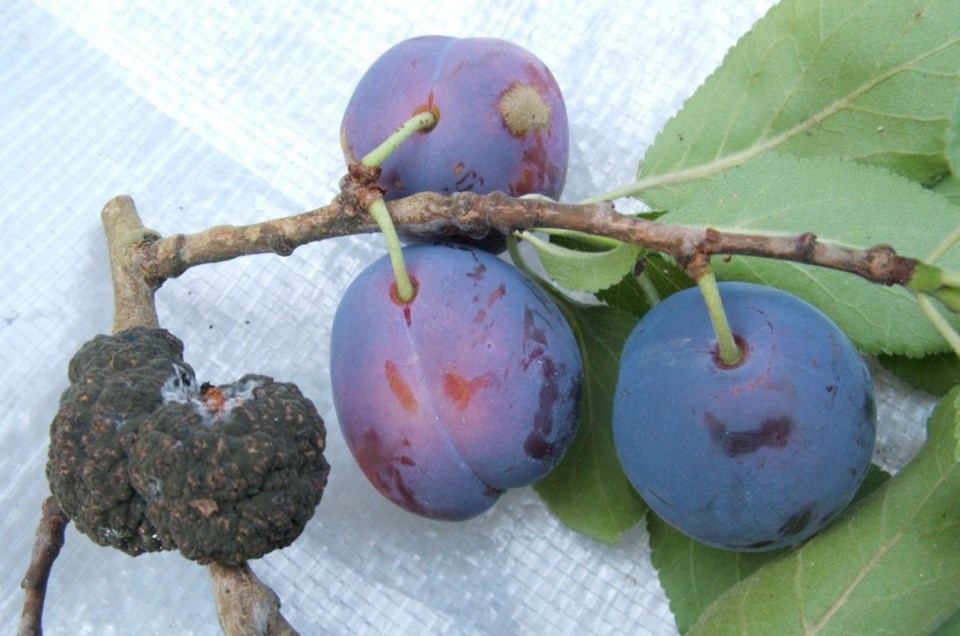Dear Helen: As I was picking prune plums recently I noticed a few twigs encircled by dark, corky swellings. What are they, and what should I do about them?
M.H.
Dark, rough swellings on (mainly) plum and cherry trees signify the presence of black knot, a fungus disease. In spring, the knots form spores that spread to infect young growth in wet weather. Newly infected shoots form swellings that harden and darken through the summer.
Italian prune plums, unfortunately, are highly susceptible to the disease. It is recommended to inspect the trees in winter and prune out infected twigs and branches. I prefer not to prune in winter, because cuts heal slowly at that time and exposing cuts of disease-prone trees to cold, wet weather seems unwise; however, if I did spot black knot in my tree in winter I would cut it out, before the spring spore formation period.
So far, I’ve avoided having to do any emergency winter pruning on the prune plum tree by going through the tree thoroughly just as the plums are starting to ripen and also during the harvest period.
My first foray into the tree, two weeks ago, was to pick the first ripe plums and check for shrivelled fruit covered in a greyish fuzz, indicating another common fungus disease of stone fruits — brown rot.
Because of the mainly dry, sunny weather I found only a few of these and removed them along with the entire twig they were growing on. I found only one twig with black knot and removed it entirely, along with the plums it held.
Twigs and fruit infected with black knot or brown rot should never be composted. Keeping a tree cleaned of infected fruit and twigs is the best prevention measure. Helpful also is keeping the tree pruned to be open-shaped and uncrowded. I find it most convenient to have secateurs with me as I pick this month, to prune as I move around the tree.
Dear Helen: I have noticed that plants, in a peripheral way, have become an election issue with concerned citizens calling on candidates to state their position on labelling genetically altered foods. In reaction to this request some are saying that the process of creating GMO products is really no different from, or less natural than, traditional breeding practices of cross-pollination. Is this true?
C.B.
No. There is nothing natural about inserting a gene of a foreign organism into a plant cell to create a trans-genetic combination of two entities that would not breed in nature.
An example is the insertion of a bacterial protein gene from Bacillus thuringiensis (Bt), which releases spores and proteins that kill caterpillars, into corn to create corn plants armed with a pesticide that will kill off pests that feed on them.
The most common technique for effecting this gene transfer is to first insert the foreign gene into a virus or bacterium, which is then used to infect a plant tissue cell. The virus or bacterium is later disarmed, but the transferred gene remains within the plant cell. A plant regenerated from that cell will incorporate the characteristics of the implanted gene.
Genetic engineering (genetic modification, transgenics) allows for a joining together of genes, through non-sexual transfer, that would not occur naturally.
The clear differences between such mechanical procedures and traditional, sexual breeding are often, perhaps deliberately, obscured. But the differences are pronounced.
Since humans have grown plants, growers have observed their plantings to select and save seeds from the best, in order to continuously improve plant performance. That is natural plant selection.
Some garden plants exchange pollen freely to create seeds that will yield variations on the parent plants. Hardy geraniums, if not dead-headed rigorously, are particularly promiscuous in this regard, producing all sorts of varied seedlings. This is natural hybridizing.
In creating deliberate, or “man-made” hybrids, two parent varieties selected for specific traits are cross pollinated to produce a hybrid, indicated as such by an F1 placed after the variety name. F1 means first filial, or the first generation offspring.
These are all sexual methods of breeding, involving only the guided evolution of a selected variety and cross-pollination among compatible plants.
GARDEN EVENT
Cactus show. The Victoria Cactus and Succulent Society will host a late summer show on Friday and Saturday, Aug. 28 and 29, in Tillicum Centre, lower level, during mall hours, 9:30 a.m. to 9 p.m. on Friday and 9:30 a.m. to 5:30 p.m. on Saturday.



